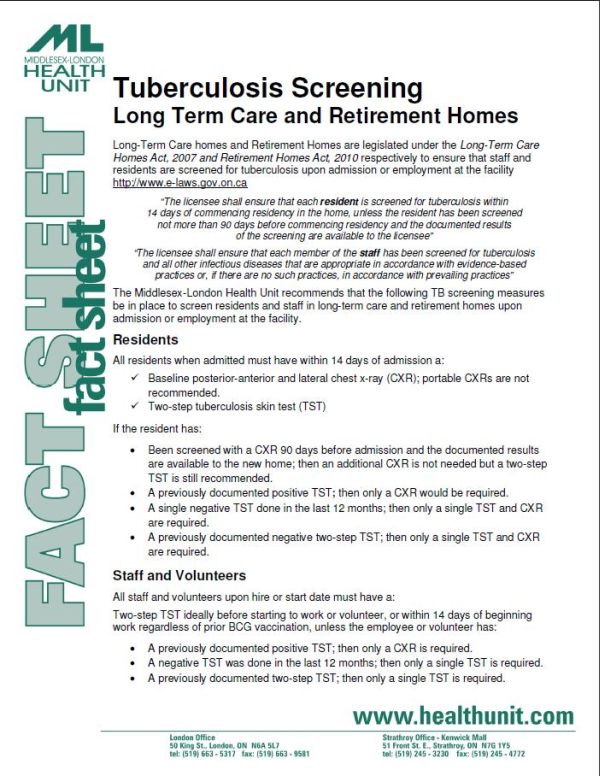Contact Us
For more information, please contact the Oral Health, Communicable Disease and Sexual Health Services Division:
- 519-663-5317
Long-term care homes and retirement homes are legislated under the Long-Term Care Homes Act, 2007 and Retirement Homes Act, 2010 respectively, to ensure that staff and residents are screened for tuberculosis upon admission or employment at the facility.
 Tuberculosis Screening: Long Term Care and Retirement Homes - Fact Sheet (PDF 86KB)
Tuberculosis Screening: Long Term Care and Retirement Homes - Fact Sheet (PDF 86KB)“The licensee shall ensure that each resident is screened for tuberculosis within 14 days of commencing residency in the home, unless the resident has been screened not more than 90 days before commencing residency and the documented results of the screening are available to the licensee”.
“The licensee shall ensure that each member of the staff has been screened for tuberculosis and all other infectious diseases that are appropriate in accordance with evidence-based practices or, if there are no such practices, in accordance with prevailing practices”.
Tuberculosis skin tests are no longer required under the Long-Term Care Homes or Retirement Homes Acts. Because of the possibility of false negative TB skin tests in the elderly and treatment for latent TB is generally not considered in people 65 years of age and older, TB skin testing is now only recommended for new residents less than 65 years of age, staff and volunteers. As well, a chest X-ray is recommended for TB screening for all new residents, and also for new staff and new volunteers who are 65 years of age and over.
For more information, please contact the Oral Health, Communicable Disease and Sexual Health Services Division:
All residents must have the following on admission to a long-term care facility or retirement home:
In addition to the chest X-ray, all residents who are less than 65 years of age must have
a two-step TB skin test (regardless of prior BCG vaccination). The first step should be done within 14 days after admission.
If the resident has:
All staff, regular volunteers, and certain other volunteers (see below) must have the following:
If the staff member or volunteer has:
New volunteers and new staff who are 65 years of age and over should also have a chest X-ray.
Note: A regular volunteer may be defined as one who expects to work 150 or more hours during the coming year, meaning approximately a half day per week. Volunteers expecting to work less than 150 hours during the coming year should be tested if they are known to belong to an at-risk population group:
A positive TB skin test (on either the first or second step) requires a medical evaluation including, but not limited to a chest X-ray, and if symptomatic, sputum testing, to rule out active TB. All positive TB skin tests, including details of the follow-up, must be reported to the Middlesex-London Health Unit (see below for reporting requirements).
Note: If active TB is suspected, place the patient in a private room, close the door, limit entry into the room, ensure staff wear a fit-tested N95 mask and if tolerated, have the resident where a surgical mask when others are in the room. Contact the Health Unit immediately.
Tuberculosis is a reportable disease under the Health Protection and Promotion Act - R.S.O. 1990, Chapter H.7. Therefore, long-term care homes must report all residents and staff with any of the following to Public Health: